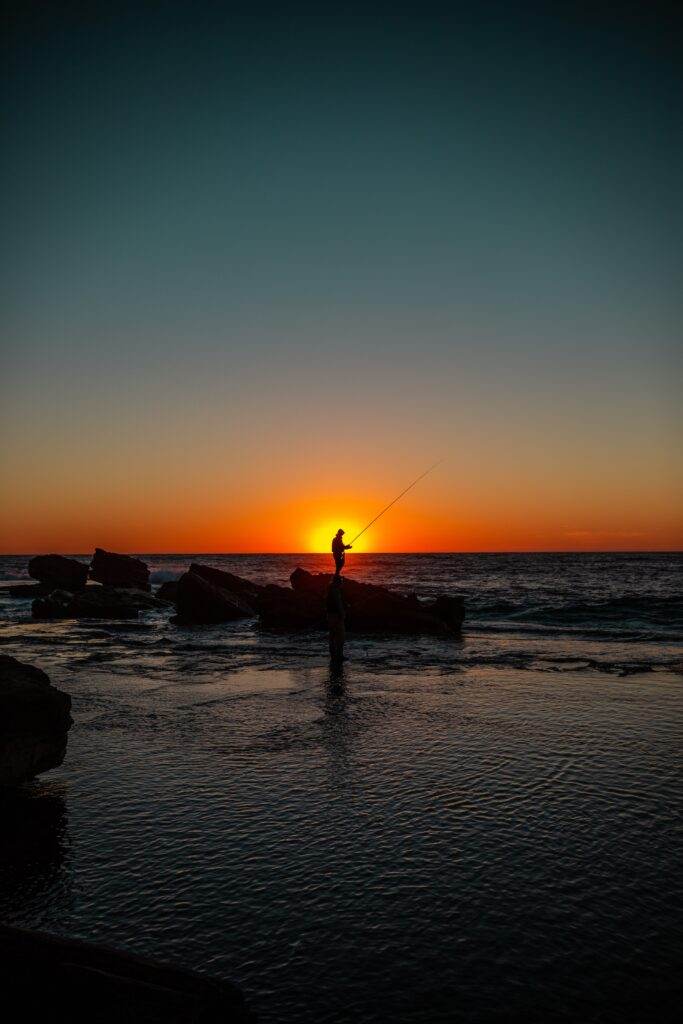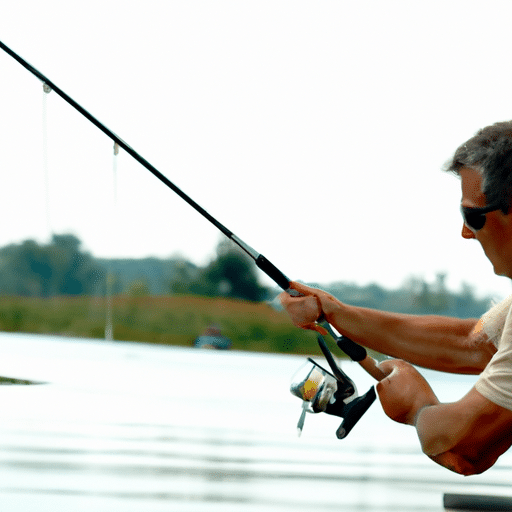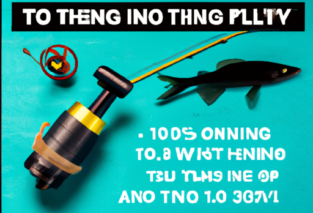If you’re an angler who enjoys the thrill of fishing in shallow water, then “Can You Go Fishing In Shallow Water: Tips And Techniques For Shallow Water Anglers” is the perfect guide for you. Packed with expert advice and practical tips, this product is designed to help you navigate the unique challenges of shallow water fishing and enhance your overall angling experience. Whether you’re a beginner or experienced angler, this comprehensive guide has everything you need to know to reel in the big catch in shallow water environments. So grab your gear and get ready to explore the world of shallow water angling like never before.

Equipment and Gear
Selecting the Right Rod and Reel
When fishing in shallow water, it is important to choose the right rod and reel that suits your fishing style and target species. A medium to light action rod is generally ideal for shallow water fishing, as it allows for better control and sensitivity when casting and reeling. Pairing this with a spinning reel is a popular choice, as it offers excellent line control and is easy to use, especially for beginners.
Choosing the Appropriate Fishing Line
Selecting the correct fishing line is crucial when fishing in shallow waters. Monofilament and fluorocarbon lines are popular choices, as they offer good strength and are less visible underwater. Monofilament lines provide better flexibility and are more forgiving in terms of knots and line management. On the other hand, fluorocarbon lines are virtually invisible underwater and have better abrasion resistance, making them suitable for targeting more wary fish species.
Using the Correct Lures and Baits
The type of lures and baits you use when fishing in shallow water can greatly influence your success. Shallow diving crankbaits, topwater lures, and soft plastic baits are all excellent choices for shallow water fishing. Shallow diving crankbaits mimic injured baitfish, enticing predatory fish to strike. Topwater lures create surface commotion, attracting fish from below. Soft plastic baits, such as worms or creature baits, can be rigged weedless and are effective in areas with vegetation or cover.
Understanding Shallow Water Habitats
Identifying Shallow Water Fishing Spots
To increase your chances of success when fishing in shallow water, it is important to identify the right fishing spots. Look for areas with submerged vegetation, such as lily pads or grass beds, as these provide cover and food sources for fish. Shallow points, drop-offs, and oyster bars are also productive spots to target. Additionally, keep an eye out for any visible signs of fish activity, such as swirls or splashes on the surface.
Knowing the Behavior of Fish in Shallow Water
Understanding the behavior of fish in shallow water is crucial for a successful fishing trip. In shallow water, fish tend to be more skittish and cautious due to the lack of depth and cover. They may spook easily, so it is important to approach quietly and stealthily. Shallow water fish also tend to be more aggressive, as they are defending their territory or hunting for food. Keep this in mind and adjust your techniques accordingly.

Techniques for Shallow Water Fishing
Casting and Retrieving Techniques
When fishing in shallow water, mastering casting and retrieving techniques is essential. Shorter casts are often more effective, as fish tend to be nearer to the shore or structures in shallow water. Using a sidearm or underhand cast can help you achieve better accuracy and reduce the chances of your line snagging on vegetation or obstructions. When retrieving your lure or bait, vary your speed and impart action to mimic the movement of natural prey.
Topwater Fishing
Topwater fishing in shallow water can be incredibly exciting and productive. Using lures that float or skim just above the surface, such as poppers, buzzbaits, or frogs, can entice fish to strike aggressively. The key to successful topwater fishing is to create commotion on the surface to attract the attention of fish. Experiment with different techniques, such as popping, walking the dog, or pausing the retrieve to trigger strikes.
Bottom Fishing
When targeting fish that are feeding near the bottom in shallow water, bottom fishing techniques can be highly effective. Choose a bait or lure that mimics the natural prey found in the area, such as crayfish or small baitfish. Use a slow and steady retrieve, keeping the lure close to the bottom. This technique can be particularly effective for species like bass or catfish that often feed on the bottom.
Managing Stealth and Noise
Approaching the Fishing Area Quietly
In shallow water fishing, stealth is crucial. Fish in shallow waters can easily be spooked by noise or sudden movements. Approach the fishing area quietly, avoiding slamming hatches or dropping anchor weights. Slowly and calmly maneuver your boat or wade into the water, taking care not to disturb the surroundings. The quieter you are, the better chance you have of not alerting the fish to your presence.
Reducing Noise and Disturbance
To minimize noise and disturbance when fishing in shallow water, consider using a push pole or trolling motor instead of a noisy outboard motor. If using an outboard motor is necessary, try to keep the speed at a minimum to reduce noise and surface disruption. Be mindful of any other sounds or movements that could startle the fish, such as dropping tackle boxes or talking loudly.

Dealing with Shallow Water Challenges
Navigating Through Shallow Waters
Navigating through shallow waters can present challenges, especially if you are in a boat. In order to avoid running aground or damaging your propeller, it is important to familiarize yourself with the water depth and potential obstacles. Use a depth finder or GPS to map out shallow areas, and proceed with caution. If possible, draft your boat or switch to a shallower draft vessel to navigate safely in shallow water.
Avoiding Snags and Obstacles
Shallow water habitats often have submerged vegetation, fallen trees, or rocky structures that can snag your line or lure. To avoid unnecessary frustration and lost tackle, it is important to be aware of these potential obstacles. Opt for weedless hooks or lures that can glide through vegetation without getting hung up. Use techniques like flipping or pitching to target specific areas and minimize the risk of snagging.
Seasonal Considerations for Shallow Water Fishing
Fishing in Shallow Water During Spring
Spring is an excellent time for shallow water fishing, as many fish species move closer to the shore in search of spawning grounds and food. Look for areas with submerged grass beds or spawning flats, as these tend to attract fish during this season. Pay attention to water temperature and target species’ feeding patterns to increase your chances of success. Experiment with different lure colors and sizes to match the changing conditions.
Shallow Water Fishing in Summer
Summer can present unique challenges for shallow water anglers, as water temperatures rise and fish become more inactive during the heat of the day. During this season, focus on early mornings or late evenings when the water is cooler and fish are more active. Look for shaded areas, deeper holes, or areas with moving water, as these can provide relief from the heat and attract fish.
Fall Tips for Shallow Water Anglers
Fall is a prime season for shallow water fishing, as fish become more active in preparation for winter. Look for areas with abundant vegetation, as dying grass or weeds can attract fish seeking shelter and food. Pay attention to changing water temperatures and adjust your techniques accordingly. Consider using lures that imitate baitfish or crayfish, as these are staple food sources for many species during the fall.
Winter Strategies for Shallow Water Fishing
Winter fishing in shallow waters can be challenging, as fish tend to become more sluggish and seek deeper, warmer waters. However, on milder winter days, fish may venture into shallower areas to feed. Focus on deeper holes or structures that offer thermal cover and concentrate fish. Slow presentations and using bait or lures that mimic slow-moving prey can increase your chances of enticing a strike.

Understanding Fish Behavior and Feeding Patterns
Understanding the Preferences of Different Species
Different species of fish have varying preferences when it comes to habitat and food sources. Research the specific species you are targeting to gain insight into their feeding habits and preferred areas. For example, bass may be more inclined to hide under submerged vegetation or ambush prey near structure, while trout may prefer cooler areas with moving water. Understanding these preferences will help you effectively target your desired species.
Recognizing Feeding Opportunities in Shallow Water
Fish in shallow water are often actively feeding, making it important to recognize feeding opportunities. Look for signs such as baitfish activity, birds diving into the water, or fish breaking the surface. These indicate areas where predatory fish may be on the hunt. Pay attention to the behavior of fish around you, as they may exhibit signs of feeding, such as swirling or splashing. By targeting these feeding opportunities, you increase your chances of landing a fish.
Safety Precautions for Shallow Water Anglers
Wearing Proper Safety Gear
Safety should always be a priority when engaging in shallow water fishing. Wear a properly fitting life jacket or personal flotation device (PFD) at all times, especially if you are wading or on a boat. Additionally, consider wearing protective footwear to prevent cuts from sharp rocks or broken shells. Always carry a means of communication, such as a cell phone or marine radio, in case of emergencies.
Being Aware of Potential Hazards
Shallow water fishing can present certain hazards that anglers should be aware of. Keep an eye out for submerged obstacles that could cause injury, such as rocks, fallen trees, or oyster beds. Be cautious when wading through unfamiliar waters, as the bottom may be slippery or uneven. In areas with strong currents or tidal changes, be mindful of the potential for sudden water level changes. Stay alert and take necessary precautions to ensure your safety.

Conservation and Ethical Practices
Understanding Catch and Release Best Practices
Conservation is important in shallow water fishing to preserve fish populations and ecosystems. Practice catch and release whenever possible, carefully handling the fish to minimize stress and injury. Use barbless hooks to make hook removal easier and reduce harm to the fish. Wet your hands before touching the fish to protect their delicate layer of mucus. Release the fish gently, supporting its body and allowing it to swim away on its own.
Respecting Shallow Water Habitats
Respecting the shallow water habitats is essential for sustaining healthy ecosystems. Do not disturb or damage vegetation, as it provides important habitat and food sources for fish and other aquatic creatures. Avoid littering and properly dispose of any trash or fishing gear. Be mindful of local regulations and fish within the limits set forth by authorities. By respecting the environment, you contribute to the long-term sustainability of shallow water habitats.
Landing and Handling Fish in Shallow Water
Using Proper Landing Techniques
When landing a fish in shallow water, it is important to use proper techniques to minimize harm to the fish. Avoid dragging the fish onto the shore or rocks, as this can cause injury. Instead, use a landing net or wet your hands before handling the fish. Carefully lift the fish out of the water, supporting its weight with both hands. If necessary, use a pair of forceps or pliers to remove the hook, taking extra care not to damage the fish’s mouth.
Handling Fish with Care
Handling fish with care is crucial for their survival after release. Avoid squeezing or putting excessive pressure on the fish, as this can cause internal injuries. Keep the fish in the water as much as possible and minimize the time it spends out of water. If you need to take photos, hold the fish properly using wet hands and support its weight. Once you have captured the moment, release the fish gently, allowing it to swim away strong and healthy.
In conclusion, fishing in shallow water can be an exhilarating and rewarding experience. By selecting the right equipment and gear, understanding the behavior of fish in shallow waters, employing the appropriate techniques, and prioritizing safety and conservation, you can enhance your chances of a successful and enjoyable shallow water fishing trip. Whether you’re targeting bass, trout, or any other shallow water species, remember to respect the environment and handle fish responsibly to ensure the sustainability of these unique habitats for generations to come.





